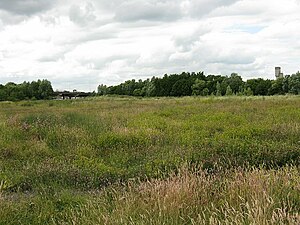The Portrack Incinerator was a municipal waste incinerator and waste-to-energy power station situated on the River Tees at Portrack in Stockton-on-Tees in County Durham, England.
| Portrack Incinerator | |
|---|---|
 | |
 | |
| Country | England |
| Location | County Durham, North East England |
| Coordinates | 54°34′16″N 1°16′00″W / 54.571196°N 1.266791°W |
| Commission date | 1975 |
| Decommission date | 1996 |
| Thermal power station | |
| Primary fuel | Waste |
grid reference NZ475198 | |
Incinerator history
editThe incinerator was opened in 1975 to burn the domestic waste of the four local authorities of Middlesbrough, Stockton on Tees, Redcar & Cleveland and Hartlepool.[1] It was praised as an environmentally friendly answer to waste management on Teesside.[2] The plant burned approximately 200,000 tonnes of waste every year and had the potential capacity to generate 20 megawatts (MW) of electricity although it never actually did so.[1] Ash from the incinerator was sent to landfill and ferrous metal baled and sold on as scrap. During the 1980s, a former quarry at Whitton was used as a site to dump the incinerator's ash.[3]
In the early 1990s, Northumbrian Water and Internal Technology Europe Ltd. applied for planning permission to build a sludge incinerator alongside the waste incinerator. These plans were refused, despite an appeal in 1992.[4]
The incinerator was closed down in November 1996, after failing to meet new emission regulations. The plant was then demolished and its site cleared between 1998 and 2000.[1] The incinerator's 300-foot (91 m) tall chimney was demolished on 14 March 1999.[5] The budget for the demolition went into the red in early 2000.[6] The north part of the site was used as the Stockton civic amenity dump, until it closed in December 2001.[1]
The incinerator was superseded by the Teesside WTE Power Station a couple of miles down river at Haverton Hill.
| Portrack Meadows Wildlife Reserve | |
|---|---|
| Location | Stockton-on-Tees, England |
| Operated by | Tees Valley Wildlife Trust |
| Website | teeswildlife.org |
Portrack Meadows Wildlife Reserve
editAfter the Portrack Incinerator site was cleared it was transformed into a site for recreation and wildlife and named Portrack Meadows Wildlife Reserve.[1] The site is managed by Tees Valley Wildlife Trust who have placed several interpretation boards around the site for the visitor. At the site's blocked-off northern road entrance is a public sculpture entitled Germination (2005) commissioned by Tees Valley Wildlife.[7][8]
Flora
editMany trees were planted around the incinerator to screen it off, but when the site was cleared to give other plants a chance to grow, many of these trees were pollarded. After clearing the incinerator site it was planted with hedgerows, oak trees and sown with wildflower seeds.[8][9] However the concrete base of the incinerator still remains under the site—a fact that may account for the extremely dense vegetation.
-
Portrack Meadows with the A19 Tees Viaduct in the distance
-
Germination sculpture at the entrance at the north end of the Portrack Meadows site
References
edit- ^ a b c d e "Portrack Meadows". Tees Wildlife. Archived from the original on 20 November 2008. Retrieved 20 April 2009.
- ^ Delplanque, Paul (9 May 2008). "What a load of rubbish!". Gazette Live. Teesside: Evening Gazette. Archived from the original on 11 May 2008. Retrieved 20 April 2009.
- ^ "Honey Pot Wood". Stockton-on-Tees. Stockton-on-Tees Borough Council. Archived from the original on 2 December 2008. Retrieved 21 April 2009.
- ^ Mr. Baldry (27 October 1992). "Sludge Incinerators". Parliamentary Debates (Hansard). Retrieved 2 September 2009.
- ^ "Symbolism of a new skyline". Wiki NorthEast. 15 March 1999. Retrieved 21 April 2009.[dead link]
- ^ Kelly, June (8 January 2000). "The knock-down price". Retrieved 25 September 2009.[dead link]
- ^ "andrew mckeown - sculptor". Andrew McKeown. Archived from the original on 28 October 2009. Retrieved 3 July 2009.; "andrew mckeown - sculptor". Archived from the original on 28 October 2009. Retrieved 3 July 2009.; "New Shoots". Teesside: Evening Gazette. 16 November 2005. Archived from the original on 22 November 2008. Retrieved 3 July 2009.; Thomas-Bailey, Carlene (4 April 2009). "Seeds of change". The Guardian. Retrieved 27 July 2009.
- ^ a b "Sculptures grace restored incinerator site". Darlington: The Northern Echo. 29 June 2005. Archived from the original on 1 October 2012. Retrieved 27 July 2009.
- ^ "Chain Gang". Teesside: Evening Gazette. 18 May 2005. Archived from the original on 7 October 2008. Retrieved 3 July 2009.; "Turf's up as mayors help create avenue of oak trees at nature site". Darlington: The Northern Echo. 14 April 2005. Retrieved 3 July 2009.[dead link]